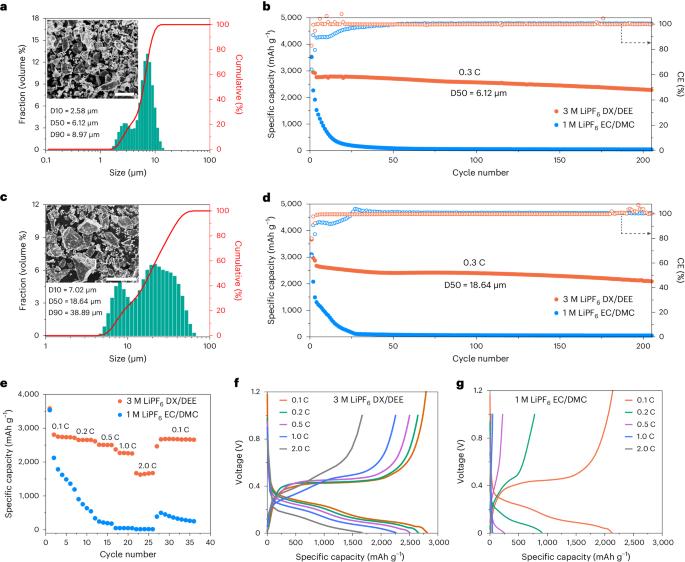用于高压锂离子电池的回收微型硅负极
IF 25.7
1区 环境科学与生态学
Q1 ENVIRONMENTAL SCIENCES
引用次数: 0
摘要
硅(Si)负极因其容量远高于普遍使用的石墨,且数量充足、质量上乘而被广泛视为锂离子电池(LIB)的变革者。大多数硅负极设计都采用纳米结构,以克服循环过程中的大体积变化,但这是以牺牲可制造性、成本优势和其他优点为代价的。在这里,我们证明了从光伏废料中回收的微尺寸硅(μm-Si)可用作阳极材料,通过合理的电解质设计,在循环 200 次后,平均库仑效率达到 99.94%,初始容量保持率为 83.13%。NCM811||μm 硅袋电池采用 1,3- 二氧六环 (DX)/1,2- 二乙氧基乙烷 (DEE) 中 3 M LiPF6 的配制醚电解质,即使在苛刻的条件下也能存活 80 个循环,并提供 340.7 Wh kg-1 的能量密度。这种独特的 SEI 化学性质使其具有令人印象深刻的电化学性能,其中柔性聚合物为主的外层能很好地将断裂的硅颗粒固定在一起,而富含 Li2O/LiF 的刚性内层则能促进离子传导并抑制副反应。我们的工作不仅为硅颗粒提供了更可持续的供应来源,还解决了微米硅负极材料面临的主要问题。硅(Si)已成为一种前景广阔的下一代阳极材料。在这里,作者回收了光伏废料中的微米级硅,这种硅可以与高电压阴极配对,用于高性能锂离子袋式电池。本文章由计算机程序翻译,如有差异,请以英文原文为准。

Recycled micro-sized silicon anode for high-voltage lithium-ion batteries
Silicon (Si) anode is widely viewed as a game changer for lithium-ion batteries (LIBs) due to its much higher capacity than the prevalent graphite and availability in sufficient quantity and quality. Most Si anode designs are nanostructured to overcome the large volume variation during cycling, but this comes at the expense of manufacturability, cost advantage and other merits. Here we demonstrate that micro-sized Si (μm-Si) recycled from photovoltaic waste can serve as anode material, exhibiting an average Coulombic efficiency of 99.94% and retaining 83.13% of its initial capacity after 200 cycles through the rational electrolyte design. With a formulated ether electrolyte of 3 M LiPF6 in 1,3-dioxane (DX)/1,2-diethoxyethane (DEE), NCM811||μm-Si pouch cells survive 80 cycles and deliver an energy density of 340.7 Wh kg−1 even under harsh conditions. Responsible for the impressive electrochemical performance is a unique SEI chemistry where the flexible polymer-dominated outer layer well holds fractured Si particles together and the rigid Li2O/LiF-rich inner layer serves to facilitate ionic conduction and suppress side reactions. Our work not only suggests a more sustainable supply source for Si particles but also addresses the major problems facing μm-Si anode materials. Silicon (Si) has emerged as a promising next-generation anode material. Here the authors recycle photovoltaic waste for micro-sized Si that can pair with high-voltage cathode for high-performance Li-ion pouch cells.
求助全文
通过发布文献求助,成功后即可免费获取论文全文。
去求助
来源期刊

Nature Sustainability
Energy-Renewable Energy, Sustainability and the Environment
CiteScore
41.90
自引率
1.10%
发文量
159
期刊介绍:
Nature Sustainability aims to facilitate cross-disciplinary dialogues and bring together research fields that contribute to understanding how we organize our lives in a finite world and the impacts of our actions.
Nature Sustainability will not only publish fundamental research but also significant investigations into policies and solutions for ensuring human well-being now and in the future.Its ultimate goal is to address the greatest challenges of our time.
 求助内容:
求助内容: 应助结果提醒方式:
应助结果提醒方式:


